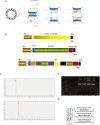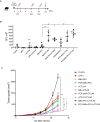Linear DNA amplicons as a novel cancer vaccine strategy
- PMID: 35668533
- PMCID: PMC9169303
- DOI: 10.1186/s13046-022-02402-5
Linear DNA amplicons as a novel cancer vaccine strategy
Abstract
Background: DNA-based vaccines represent a simple, safe and promising strategy for harnessing the immune system to fight infectious diseases as well as various forms of cancer and thus are considered an important tool in the cancer immunotherapy toolbox. Nonetheless, the manufacture of plasmid DNA vaccines has several drawbacks, including long lead times and the need to remove impurities from bacterial cultures. Here we report the development of polymerase chain reaction (PCR)-produced amplicon expression vectors as DNA vaccines and their in vivo application to elicit antigen-specific immune responses in animal cancer models.
Methods: Plasmid DNA and amplicon expression was assessed both in vitro, by Hela cells transfection, and in vivo, by evaluating luciferase expression in wild-type mice through optical imaging. Immunogenicity induced by DNA amplicons was assessed by vaccinating wild-type mice against a tumor-associated antigen, whereas the antitumoral effect of DNA amplicons was evaluated in a murine cancer model in combination with immune-checkpoint inhibitors (ICIs).
Results: Amplicons encoding tumor-associated-antigens, such as telomerase reverse transcriptase or neoantigens expressed by murine tumor cell lines, were able to elicit antigen-specific immune responses and proved to significantly impact tumor growth when administered in combination with ICIs.
Conclusions: These results strongly support the further exploration of the use of PCR-based amplicons as an innovative immunotherapeutic approach to cancer treatment.
Keywords: Amplicons; Cancer immunotherapy; DNA vaccine; PCR.
© 2022. The Author(s).
Conflict of interest statement
Evvivax, Takis and NeoMatrix are currently developing proprietary nucleic-acid vaccines based on DNA-EP. Applied DNA is commercializing LinearDNA™, its proprietary, large-scale PCR-based manufacturing platform that allows for the large-scale production of specific DNA sequences. The Company’s common stock is listed on NASDAQ under ticker symbol ‘APDN,’ and its publicly traded warrants are listed on OTC under ticker symbol ‘APPDW.’
Figures





References
-
- Conforti A, Palombo F, Aurisicchio L. DNA/RNA based vaccines. In: Buonaguro L, Van der Burg S, editors. Cancer vaccines as Immunotherapy of Cance. Elsevier. 2022. In press.
MeSH terms
Substances
Grants and funding
LinkOut - more resources
Full Text Sources
Other Literature Sources
Medical

